
I was once again drawn like a magnet to the Meatpacking District on Greenwich Village’s far west side, which is one of those neighborhoods that has been reinvented twice over…since I began covering it around 2000. There always seems to be some new infrastructural item over there; I visited High Line Park when it was opened in various stages beginning in 2009, and last year (2022) I visited the considerably-hyped Little Island, Barry Diller’s playground plopped in the Hudson. A lot of people like it, but it left me somewhat bored. Maybe I will give it a second try, but on this day in November 2023, I didn’t…because I was here to see another newly opened park, Gansevoort Peninsula, which I’ll get to discussing a bit further down.
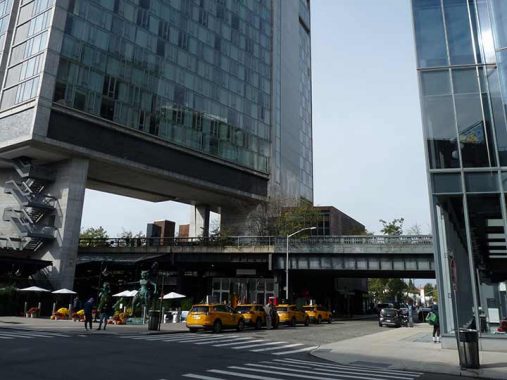
I began at West 13th Street and Washington Street. The oldest object in the picture is of course the High Line itself which was built as the West Side Freight Railroad in 1934, meant to replace the active railroad that traveled down the center of 10th Avenue. It served businesses in Chelsea and the West Village until 1980, and subsequently was torn down south of Gansevoort Street and was going to be demolished entirely until neighborhood groups in the areas it served pushed for it to be converted to a linear park. The rail line’s owner, CSX, sold it to New York City but with a stipulation that it not be used for further rail traffic. (I always thought it would make a dandy southern extension of the #7 Flushing Line.) Many aspects of its former railroad identity, such as ties and rails, have been retained.
On the left is Andre Balazs’ luxury hotel, Standard New York, which was built to straddle High Line Park, and is accompanied by the restaurant Standard Grill. In the Standard’s early days, its guests used to surprise High Line strollers by appearing half- or totally undressed at the windows overlooking the park.
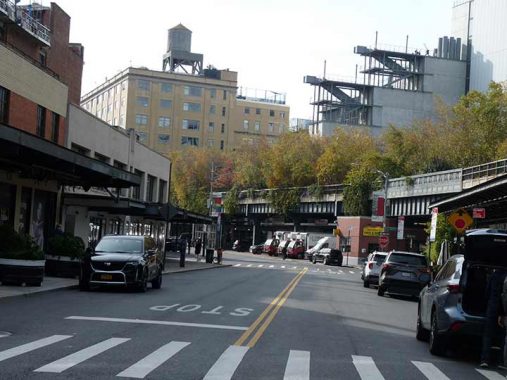
Looking south on Washington from West 13th. On the left are repurposed butchers/meat processing buildings and on the right is the High Line and toward the rear, the new Whitney Museum.
In The Standard Grill’s outdoor seating area, a pair of large video game-inspired sculptures have appeared. The internet is silent about these, and the sculptor’s name is absent from the bases.
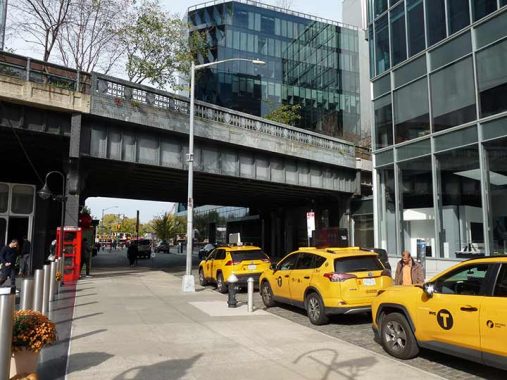
Also of interest, to me at least, was the red telephone booth toward the back of the plaza. It’s apparently a public phone, though I didn’t try the door or use the pushbutton phone inside. A couple of street public phone booths remain on West End Avenue in the Upper West Side, and standing phone booths are secreted in bars and shops all over town. I like the exposed rivets and bolts, 1934 construction, on the High Line pillars, as well as the color contrast with the yellow cabs on West 13th and the red booth.
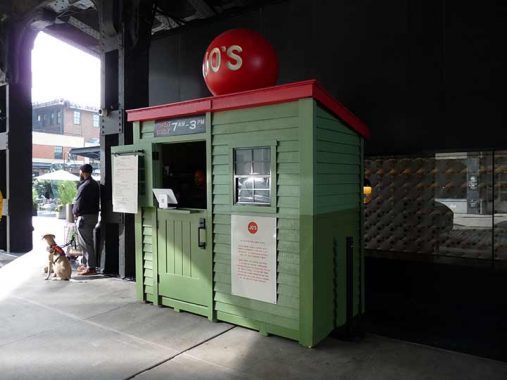
One of the smallest coffee shops in NYC is Jo’s, adjacent to the Standard beneath the High Line on West 13th. This is a branch of a coffee chain that originated in Austin, Texas. From its website:
The original Jo’s Coffee opened on South Congress Ave. in Austin in 1999 and has been serving coffee, tacos, and prime people watching ever since. A community hub, Jo’s is as well known for its signature Iced Turbo as it is for the fundraisers, concerts, and dog-friendly shindigs it hosts.
Jo’s is a central part of life in Austin and the Bunkhouse family of properties—which is part of the Standard family. It’s been keeping Austin running for decades, so now we’re here to spread a little bit of that caffeinated love to NYC.
Days Gone By
As stated above, few neighborhoods in NYC have changed quite as much as the Metapacking District. I thought I would show a few photos to illustrate this assertion. First, here’s a look at #449 West 13th, between the High Line and West Street, in 1940 and today. Most meat wholesalers hung on until the mid to late 1990s, but by then change was afoot to retail and residential and many of them moved to the Hunts Point Cooperative Market, and the New York Dressed Poultry Terminal replaced by a luxury high rise.
It’s hard to imagine now — the West Village is a quiet residential area — but the 9th Avenue El once clattered above Greenwich Street. Here is what 48-50 Gansevoort Street at Greenwich looked like in 1940 and today. It’s the same building, just repurposed from Sorrento Importing to Hermes luxury goods.
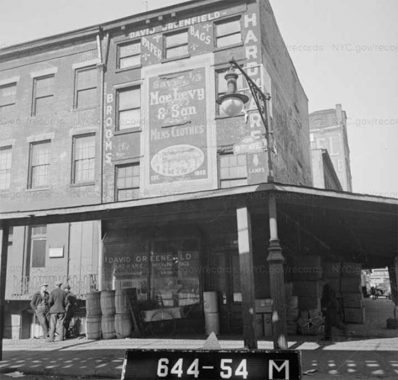
Moe Levy and Son men’s clothing and David Greenfield Hardware, #7 9th Avenue at Little west 12th Street, 1940. For information on Moe Levy, I’ll once again turn to the Indispensable Walter Grutchfield…
Moe Levy (1865-1939) manufactured and retailed men’s clothing and specialized in low prices. From the home base of 119-125 Walker St. (which would now be considered a part of Chinatown) he opened numerous branch outlets in the city including Brooklyn, the Bronx and Jamaica, Queens. Particularly long-lived was the branch store on East 149 St. in the Bronx, first at 409 E. 149 (1921-1939), then across the street at 380 E. 149 (1940-1951).
Moe Levy’s obituary in the New York Times, 19 Aug. 1939, read in part, “Moe Levy, pioneer in the low-priced retail men’s clothing field and founder of the chain of stores which bears his name, died of heart disease early yesterday morning in his home, 300 Central Park West. His age was 74. An outstanding figure among the clothing merchants of the city for many of the fifty-seven years since he started business in a tiny shop in Walker Street, Mr. Levy had been forced by his health to take a less active part in the business in recent years. His health had been failing for some time and he had been confined to bed for a week when death occurred. Mr. Levy’s first little shop was on the site of the company’s main store at 119 Walker Street. Seven other large stores scattered about the city make up the chain built up by the man who started to work at the age of 14. He was born in Suvalk, Russia, on Jan. 1, 1865, and was brought to this country when he was 3 years old. He went to work when he was graduated from grammar school and was still a boy when he went into business for himself. Despite his youth, Mr. Levy had a flair for retailing and he soon won a steady clientele. As his business increased and additional stores were opened and subsequently enlarged, Mr. Levy made a point of keeping in personal contact with his customers. Until his health failed he could be seen at his stores, always impeccably dressed and with a flower in his buttonhole…”
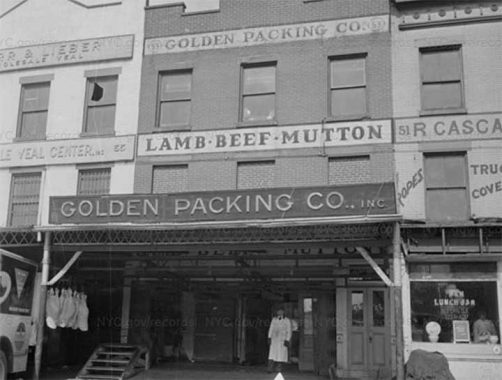
#53 Little West 12th Street in 1940. Golden Packing handled beef, lamb, and lamb when it got a bit older.
Here’s #67 and #69 Gansevoort Street in 1940 and today. In 1940, #67 housed a butter and eggs dealer, John Dupont. NYC actually had a dairy and eggs district until the 1960s centered on Duane Street in Washington Market, demolished around 1980 and replaced by the Independence Plaza housing project.
#69 is a bit more complicated. Today’s #69 is one story only whereas in 1940 it was three stories; either two were lopped off, or it’s a new building. The constant is R & L Restaurant, whose newer 1950s signage is still in place today, as it was in the 1990s up to 2008 when it was home to Florent, which hosted early morning meat wholesalers and club kids and afternoon families and tourists with equal aplomb.
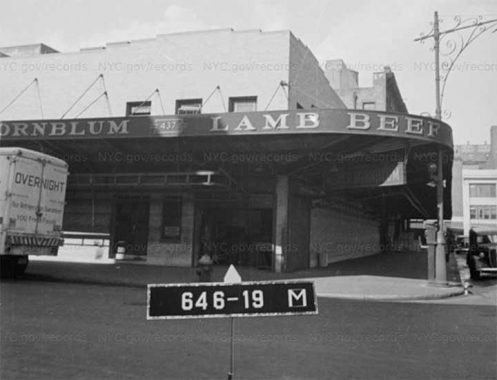
Here’s Kornblum Meats at #437 West 13th at Washington Street. Today (2023) this site is occupied by a glassy high rise with a Tesla electric car dealer on the ground floor. Note the partial view of the lamppost on the right, with its intricate metalwork. This type appeared on side streets in Manhattan especially in wholesale market and industrial areas. All had been wiped out by the time I was on the scene in the swinging sixties.
Not all of the Meatpacking District’s meat dealers have been displaced. West 13th Street and West Street still host Wechsler Beef, London Meat and interstate Foods, which provides a contrast with the new downtown location of the Whitney Museum of Modern Art.
The museum evolved out of the personal art collection of Gertrude Vanderbilt Whitney, a member of two of NYC’s wealthiest and historic families. The Museum was founded in 1931 on West 8th Street, moved to West 54th Street in 1954, to Madison Avenue and East 75th in 1966, and finally to their new glassy, cantilevered headquarters on Gansevoort between West and Washington designed by Renzo Piano, also the architect behind the new New York Times building on 8th Avenue and new buildings in the Columbia University Manhattanville campus.
According to the Museum’s website, “The Whitney’s collection includes over 21,000 works created by more than 3,000 artists in the United States during the twentieth and twenty-first centuries. At its core are Museum founder Gertrude Vanderbilt Whitney’s personal holdings, totaling some 600 works when the Museum opened in 1931.”
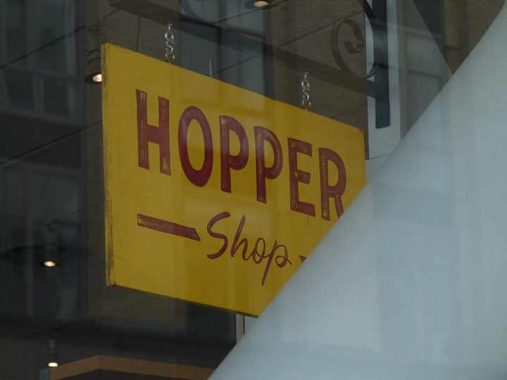
Recently, I had every intention to visit for the first time when the museum presented an Edward Hopper‘s New York exhibition, but I was sidelined for several months with what turned out to be a hernia and couldn’t get around much. I’ll get in eventually I’m sure.
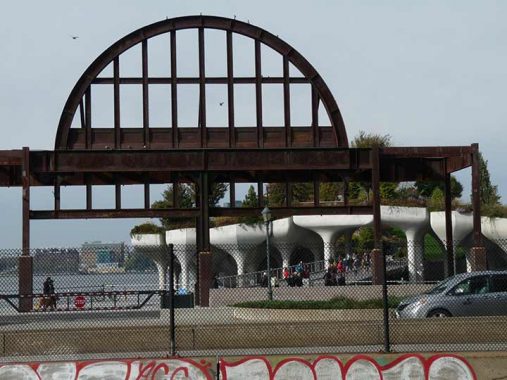
This gate, at the head of what was Pier 54, is the last remnant of a terminal building for White Star ocean liners. Having been preserved by serendipity, it’s now part of Hudson River Park. One of the spectacular ocean liners that used this gate in their heyday would have been the Titanic, though he great liner was due to arrive at nearby Pier 58 — if fate had not intervened. It was there that passengers from the doomed vessel debarked after they were picked up in the icy North Atlantic Ocean by the Carpathia, operated by Cunard.
This is where the RMS Lusitania, the fastest, one of the most luxurious, and second largest liner in the world departed on its final voyage. On May 1st 1915, 1900 people departed Pier 54 for a voyage that would be implanted in the memory of folks for years to come. On the 7th of May, the Lusitania was torpedoed by a German U-boat, sinking in 18 minutes, and taking 1200 victims down with it.
Most of Pier 54 has been demolished, and a new island park, Little Island, opened during the COVID-19 pandemic. The park will not be officially part of Hudson River Park; instead, it is being privately funded and built by media mogul Barry Diller and his wife, fashion designer Diane Von Furstenberg. The park is constructed on 132 golf tee-shaped pylons sunk into the Hudson River bed. The park features nature trails, hills, and a 700-seat amphitheater. The park’s design is by Thomas Heatherwick, who also designed “The Vessel,” the climbing structure in Hudson Yards further north…now closed because it became a popular suicide venue.
Located in Hudson River Park just south of Pier 54, Gansevoort Peninsula is NYC’s newest park section, opened to the public in 2023. It offers athletic fields, views of the river and New Jersey, a curated salt marsh, and unusually, Manhattan’s only beach, where tanning is permitted but not swimming.
1,200 lbs. of sand were trucked in, concrete and wood walkways were installed, and there are Adirondack chairs and picnic tables with views looking south along the Hudson River toward the Statue of Liberty and Jersey City. I was wondering what that thin metal pipe structure was along the beach, which I found something of an annoyance since it interrupted the view. I thought it was a leftover industrial structure. Instead, it is an art installation by David Hammons called “Day’s End.” It is an homage of sorts to a previous installation in 1975 by Gordon Matta-Clark (that I don’t recall at all).
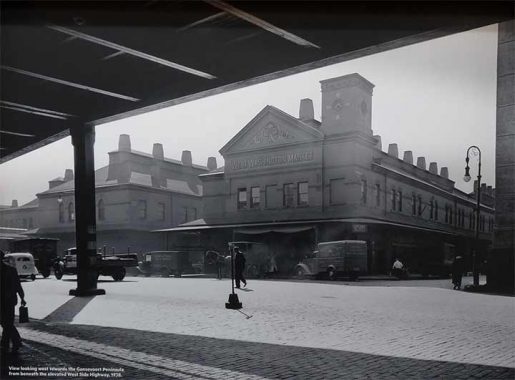
Of course, from the late 1800s to the mid-20th Century things looked considerably different here, because instead of a beach, this is where commerce and hard work was taking place. Goods, which included comestibles such as beef and poultry arriving by ship on the Hudson River piers were sold here in what was known as West Washington Market from 1887 to the 1950s in a set of buildings arranged on a mini-grid of streets. Its proximity gave rise to the Meatpacking District on the east side of West Street.
In 1939, the WPA Guide to New York City described the scene at both the Gansevoort Farmer’s Market and the West Washington Market:
“Gansevoort Market, or ‘Farmers’ Market,’ as it is generally known, occupies the block between Gansevoort and Little West Twelfth streets. Farmers from Long Island, Staten Island, New Jersey, and Connecticut bring their produce here at night for sale under supervision of the Department of Public Markets. Activities begin at 4 a.m. Farmers in overalls and mud-caked shoes stand in trucks, shouting their wares. Commission merchants, pushcart vendors, and restaurant buyers trudge warily from one stand to another, digging arms into baskets of fruits or vegetables to ascertain quality. Trucks move continually in and out among the piled crates of tomatoes, beans, cabbages, lettuce, and other greens in the street. Hungry derelicts wander about in the hope of picking up a stray vegetable dropped from some truck, while patient nuns wait to receive leftover, unsalable goods for distribution among the destitute. The market closes at 10 a.m. and is not open Sundays or holidays. Across West Street is the West Washington market, comprising ten quaint red brick buildings which house a live poultry market patronized mostly by kosher butchers Since poultry requires ample heat in winter, every stall is equipped with a furnace, so that each roof adds more than a dozen chimneys to its picturesque architecture.” [Village Preservation]
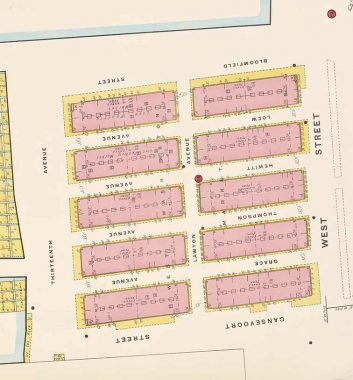
This grid included a western extension of Gansevoort Street (from which the peninsula takes its name) as well as Grace, Thompson, Hewitt, Loew, Lawton Avenues, Bloomfield Street, and surprisingly, 13th Avenue.

The western walkway in Gansevoort Peninsula along the Hudson River assumes the position of the former 13th Avenue, though there is no signage indicative of it; perhaps that will come later.
Another section of 13th Avenue ran along the Hudson between West 22nd and 30th Streets. As that roadway sits a block west of 11th Avenue, it was logically renamed 12th Avenue in 1942.
|
|
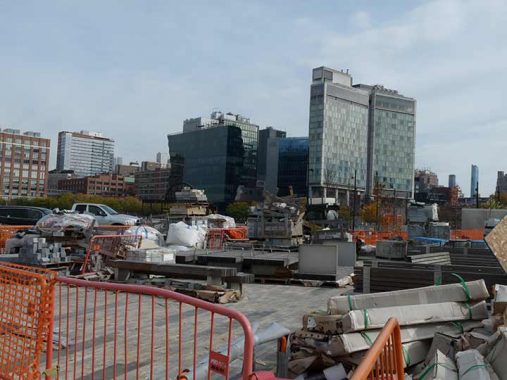

The only section of Gansevoort Peninsula that was still under construction in late 2023 is along the access road to the FDNY’s fireboat station. That access road sits in place of the former Bloomfield Street, which remained in street directories and maps even after West Washington Market was shuttered and torn down in the 1950s. The Standard Hotel is prominent in the background.
|
|
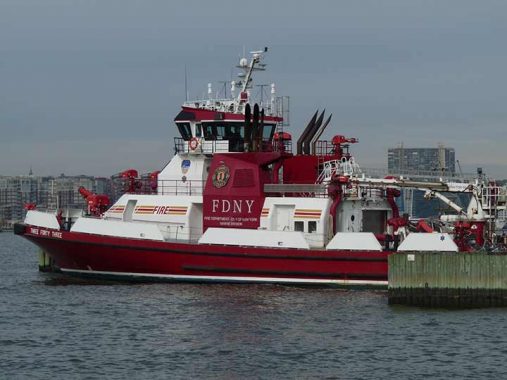
Three Forty Three is a Fire Department of New York fireboat commissioned on September 10, 2010. At 140 feet in length and weighing 500 tons it is the FDNY’s largest fireboat, and can pump 50,000 gallons of water per minute. It was named for the 343 FDNY personnel killed on duty on 9/11/01 and serves FDNY Marine Company 1.
The remains of Piers 52 and 53, in the form of wood pilings, can be seen from the west walkway in Gansevoort Peninsula.
From the waterfront I swung inland on a walk that eventually took me to the East Village; I will feature those findings on a future page. If you’ve read Forgotten NY for awhile you’ve seen the above image before but I can never resist showing these meat carcasses at Gansevoort and Washington Streets at what is now the south end of High Line Park. I got the older image when I was working at Macy’s in 2000 and took the train downtown on my lunch break and serendipitously found the carcasses sitting there.
I see a lot of shade thrown the High Line’s way because it seems to attract only tourists instead of natives, which some see as a bad thing. (I have been a tourist in my hometown for over 60 years.) I have always enjoyed the rail to trail conception when I have seen it in other cities (Paris has one–I have seen the photos) and Chicago recently opened one. I think the developers did well–I like the signage, which isn’t the standard Department of Transportation format. The only thing I don’t like are the grooves and bumps in the pavement, upon which it is easy to turn an ankle. Also, developers have raced to outdo each other in building weirdly-designed buildings along the line, many of which have decimated the sight lines and views.
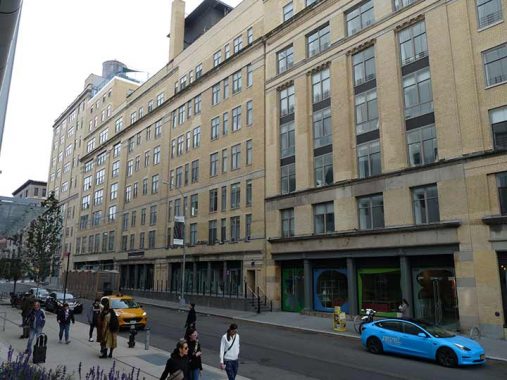
A group of former “ice houses” faces Gansevoort Street across from the Whitney between Washington and West Street, built in an era when refrigeration was not universal.
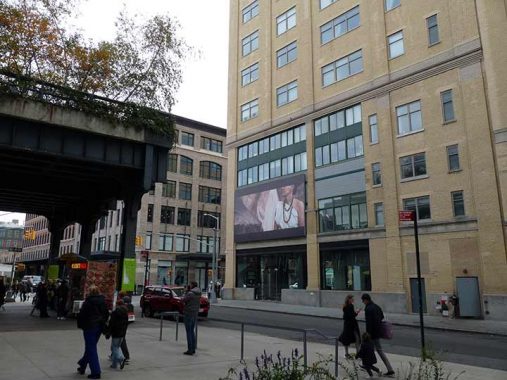
This view of the south end of the High Line at Gansevoort and Washington reveals a bank of windows that replaced the former elevated trackway. South of here, on the way to St. John’s Terminal at Houston Street, the elevated freight railroad actually was built through several buildings. Within, there were loading docks where goods could be offloaded.
I don’t often say this about developers, but BKSK did a great job with #60-68 Gansevoort, along with the corner building at Washington, #74, as they added three floors to a row of one-story brick buildings formerly housing mostly meat and produce wholesalers, in a project called Gansevoort Row.
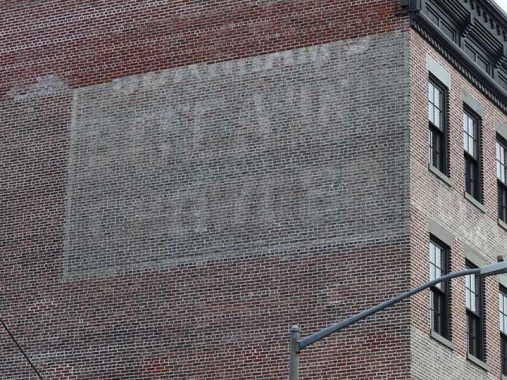
It appears that the Burnham’s Beef Wine painted ad on Gansevoort has now been partially obscured as new ownership repointed the bricks. A better view is obtainable here. “Beef Wine” was a patent medicine popular in the 1900’s, comprised of port wine fortified with beef extract and iron, not unlike the tonic “Hadacol” that was so popular in the Deep South in the 1940’s which was Iron and a Vitamin B complex in a 12% alcohol base. In this area formerly filled with slaughterhouses and meat wholesalers, “beef wine” is appropriate.
This grand old 5-story building at 55 Gansevoort on a triangular plot was designed by architect Joseph Dunn and completed in 1887. Early tenants included the New England Biscuit Works and Elmer Burnham Packing. Faded signs for the biscuit company, as well as Burnham’s Beef Wine and “Clam Chowder” and “Clam Boullion” can still be read (now barely) on the front and sides. Food wholesalers have comprised the majority of the building’s tenants over the years. Recent restoration of the brickwork have largely obscured the lettering on the exterior.
Travel & Leisure makes no bones about the clientele the new hotel located here wishes to attract:
New York City may have it all, but tranquility and privacy are far from guaranteed in a city of eight million people. That’s precisely what a new hospitality project by RH (formerly Restoration Hardware) aims to offer its well-heeled guests: comfort, exclusivity, and total privacy.
RH Guesthouse, which opens [September 2022] on 55 Gansevoort Street in Manhattan’s Meatpacking District, is housed in a historic 19th-century triangular loft building, meticulously restored and reimagined to reflect the property’s elevated aesthetics and unique concept.
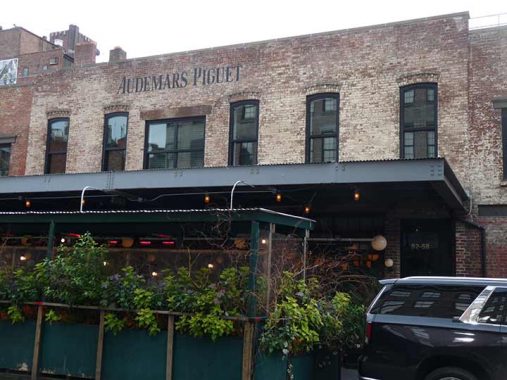
#52 Gansevoort was a wholesale fruit and vegetable dealer in 1940, but today it hosts Pastis, the longtime Meatpacking District restaurant, as well as French luxury goods retailer Audemars Piguet. The restaurant is obscured behind the COVID-19 gutter dining shed.
The intersection of Greenwich Street, Gansevoort Street, 9th Avenue and Little West 12th was never given a “square” name but until recently it was one of my favorite intersections because it was a vast spread of Belgian block street paving. The Department of Transportation has tamed it in recent years by adding bollards and seating, and repaving and replacing some of the brickwork.
Until 1940, the plaza was punctuated by the clattering 9th Avenue El. Dock workers and food wholesalers were delivered almost door to door by the el; today, the closest train is A/C/E at the 14th Street station at 8th Avenue. (Like I said before, the High Line would have made a handy southern Flushing Line extension.)
I dub thee “Gansevoort Plaza.”
Despite the rigors of over a century’s worth of wind, rain and storms, the painted sign identifying Middendorf & Rohrs Grocers is still identifiable at #1 Little West 12th Street. here at “Gansevoort Plaza.” The building has an oddly slanted shape as it fronts on both Gansevoort and Little West 12th, which intersect here. There also seems to be a pentimento effect here with other ghosts of words, especially on the right side.
The basic no-nonsense brick building was constructed in 1887, while M&R, who built #3 Little West 12th in 1918 (seen on the left side) operated a wholesale grocery in the building from 1883 to 1964, with the Rohr nephews, the oldest of whom lived until 1965, carrying on the business after the deaths of the original owners, Henry Middendorf and Herman Rohr.
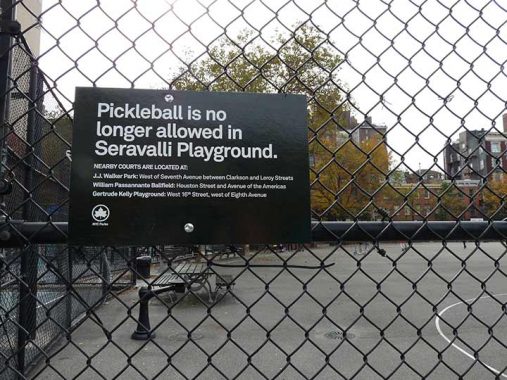
In early 2022 I noticed the pickleball craze had come to Seravalli Playground at Hudson and Gansevoort. Basically scaled-down tennis, the game has spread like wildfire in recent years, but Village residents had complained that the pickleball court was taking up too much space in the park, taking play space away from the kiddies. Pickleball is available at nearby James J. Walker Park at Hudson Street and St. Luke’s Place.
As always, “comment…as you see fit.” I earn a small payment when you click on any ad on the site. Take a look at the new JOBS link in the red toolbar at the top of the page on the desktop version, as I also get a small payment when you view a job via that link.
11/26/23

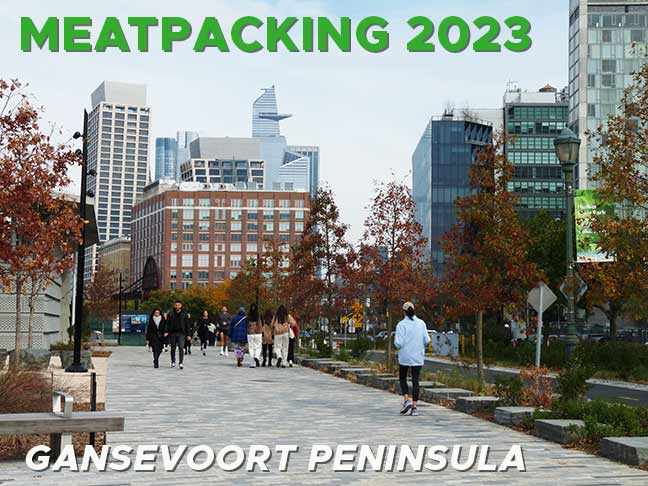
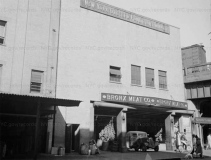
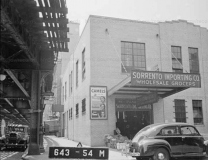
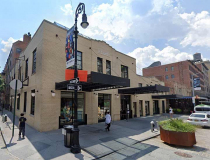
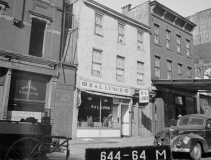
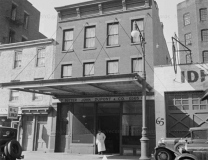
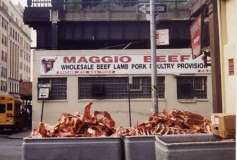
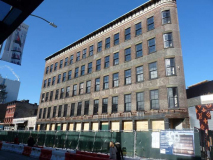
8 comments
It would have been more NY to say:”Pickleball is no longer welcome here”
Chris & Peter: Where I live either one of your statements about pickleball would be considered fighting words. The development where I live in AZ has tennis courts that were overrun by pickleball players. To avoid civil war,
the HOA will begin to construct dedicated pickleball courts a safe distance from the tennis courts. It would be a good idea to make the pickleball courts indoor rather than outdoor due to the fact that the wiffleball used is hollow & therefore light & at the mercy of the sudden wind gusts we experience occasionally. The most ironic part of the situation is that most of the year the courts are vacant due to almost perpetual heat. The few weeks of pleasant temperatures fans the flames of the pickleball players’ enthusiasm to a fever pitch. For the sake of your safety consider your comments about the sport carefully.
I am of the view that the ideal use of an old rail freight line is reactivation as a new rail freight line. Nonetheless, as (at least in New York) there was zero chance that the West Side freight line would ever see freight rail service again, the High Line is a decent substitute.
Also, I believe we have reached Peak Pickleball and it’s all downhill from here.
Pier 58 had a short mention in the movie “Ghostbusters”, when a panicked aid to the Mayor (who looked remarkably like Ed Koch) announced that the Titanic had just arrived!
I always wondered if I’m one of the few who thinks it’s strange for areas to still keep the name of something that hasn’t been there for a while, but that’s probably the case for a lot of cities especially with NYC having many of those alone.
Pickleball looks like “scaled-up ping-pong.” The trouble is, it sounds like it too, and the “Crack of the bat” sound made when paddle hits ball, multiplied by several courts, may have made for neighbors to be annoyed at hearing it all day.in summer.
Being away from NY for 22 years now (Thank goodness!) I had to Google pickleball to see what it is. In the very rural area where I now live, a game called cornhole is popular. If the name is any indication, ya’d think cornhole would go over big in the Village…..
The artist for the Pokemon statues is Daniel Arsham, according to Time Out. They’re an official collaboration with the Pokemon company. The Mewtwo was particularly unsettling when I saw it last Saturday.